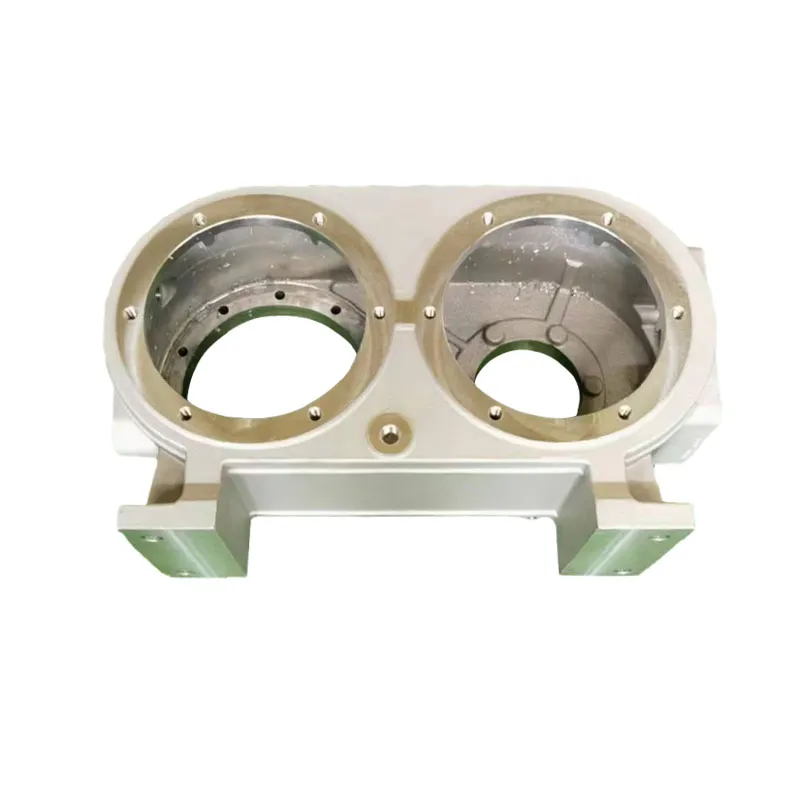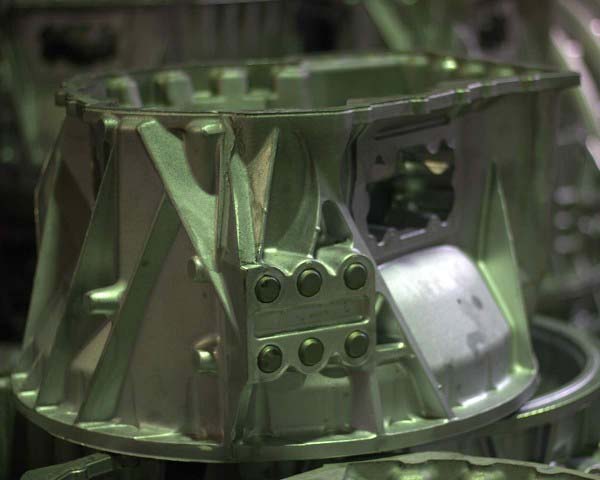How an Aluminum Casting Company supports innovation in production
Wiki Article
Recognizing the Environmental Benefits of Aluminum Shop Techniques
Aluminum factory techniques play an important duty ahead of time sustainability within the production industry. By carrying out advanced recycling approaches and energy-efficient techniques, these strategies substantially minimize waste and carbon footprints. Ingenious casting approaches better boost resource preservation efforts. As sectors progressively focus on ecological responsibility, recognizing the complete effect of these techniques comes to be crucial. What details advancements are blazing a trail in this change?The Function of Aluminum in Sustainable Production
Lots of products contribute to lasting manufacturing, light weight aluminum stands out due to its unique residential or commercial properties and recyclability. This lightweight steel is not just durable but additionally has superb rust resistance, making it an ideal choice for different applications, from automotive to building. Its high strength-to-weight proportion leads to energy savings during transportation and use. In addition, light weight aluminum can be recycled indefinitely without shedding its inherent top qualities, advertising a circular economic climate.The production procedure of aluminum has progressed, incorporating energy-efficient approaches that lower carbon footprints. By using renewable resource resources, manufacturers are significantly minimizing the ecological impact related to aluminum production. In addition, the usage of recycled aluminum calls for considerably less power contrasted to drawing out and improving main light weight aluminum, leading to reduced greenhouse gas emissions. As markets seek sustainable remedies, light weight aluminum's flexibility and eco-friendly characteristics placement it as a pivotal product in the quest of greener manufacturing methods.
Advanced Recycling Techniques in Light Weight Aluminum Foundries
Advanced reusing methods in aluminum factories are transforming the way scrap aluminum is refined and recycled. Innovative approaches, such as closed-loop recycling systems, enable factories to redeem light weight aluminum from production waste and outdated items effectively. These systems decrease material loss and enhance the top quality of recycled aluminum, making it a feasible alternative to key aluminum production.Additionally, progressed arranging modern technologies, including automated optical sorting and X-ray fluorescence, improve the splitting up of aluminum from other products, making certain higher pureness levels in recycled outputs. This precision minimizes contamination, which can endanger the honesty of the end product.
Furthermore, the integration of sophisticated melting modern technologies, such as induction melting and energy-efficient furnaces, improves the reusing process, decreasing power intake. Jointly, these innovations add to a much more sustainable aluminum market by minimizing reliance on virgin products and lowering greenhouse gas emissions linked with light weight aluminum manufacturing.
Energy Effectiveness Improvements in Shop Procedures
Energy efficiency enhancements in aluminum shop operations can significantly improve sustainability techniques. Applying waste warm recuperation systems enables factories to repurpose excess energy, minimizing overall energy intake. Furthermore, innovations in process automation simplify operations, leading to decreased waste and enhanced resource use.Waste Warm Recovery
Applying waste warmth recovery systems in light weight aluminum foundries considerably boosts energy effectiveness by recording and reusing excess thermal power created throughout production procedures. These systems facilitate the conversion of squandered warmth into functional power, which can be utilized for numerous applications within the foundry, such as pre-heating products or powering tools. By recouping heat that would certainly otherwise be expelled right into the atmosphere, shops can substantially minimize their general power intake and greenhouse gas emissions. This strategy not just decreases functional costs however additionally promotes lasting techniques within the market. Additionally, the fostering of waste heat recuperation technologies straightens with regulative standards targeted at decreasing ecological influence, making it a vital component of modern-day aluminum factory procedures.Refine Automation Conveniences
Automating processes in aluminum factories can considerably enhance power performance by enhancing manufacturing operations and decreasing waste. By executing sophisticated innovations such as robotics and artificial intelligence, shops can simplify procedures, lessening unneeded energy intake. Automated systems promote exact control over temperature and product handling, making sure that power is utilized just when needed. Additionally, real-time tracking permits prompt adjustments, lowering the threat of energy loss. The combination of automation not just improves performance yet additionally reduces operational expenses, making shops more competitive. As an outcome, these energy-efficient practices contribute considerably to sustainability goals, reducing the ecological impact of aluminum production while meeting raising market demands - Aluminum Casting Company. Improved power performance through automation stands for an essential action towards greener foundry proceduresMinimizing Waste Via Cutting-edge Casting Approaches
Innovative casting approaches play an essential role in reducing waste in light weight aluminum shops. Techniques such as innovative molding and the utilization of recyclable materials considerably minimize manufacturing scrap. These techniques not only boost performance however likewise contribute to an extra sustainable production process.Advanced Molding Techniques
As markets significantly prioritize sustainability, advanced molding strategies in aluminum factories emerge as effective options for decreasing waste. These cutting-edge approaches, such as 3D printing and precision mold making, substantially boost the effectiveness of the spreading process. By utilizing computer-aided design (CAD) and simulation technologies, makers can enhance mold and mildew geometry, reducing product use while maintaining item honesty. Additionally, advanced strategies make it possible for the production of intricate shapes that traditional techniques can not accomplish, decreasing the demand for additional machining and therefore decreasing scrap product. The versatility of these strategies allows for fast prototyping, more reducing preparations and energy intake. Overall, the implementation of innovative molding strategies represents an essential step towards environmentally accountable light weight aluminum production, aligning with international sustainability objectives.Recyclable Material Application
Recyclable products play an essential role in lowering waste within light weight aluminum foundries, transforming the spreading landscape through their efficient application. By including scrap light weight aluminum and various other recyclable elements into the production procedure, shops can substantially decrease the need for virgin materials. This not just conserves all-natural sources yet likewise lessens energy consumption connected with mining and refining. Innovative casting approaches, such as die casting and sand spreading, permit seamless combination of these materials, making sure top notch outcomes. The usage of recyclable products fosters a circular economic situation, where sources are constantly recycled and repurposed, minimizing land fill contributions. Ultimately, the critical use of recyclables boosts sustainability while advertising cost-effectiveness in light weight aluminum factory operations.Lessening Manufacturing Scrap

Life Cycle Assessment of Aluminum Products
Although light weight aluminum is commonly identified for its resilient and light-weight properties, a thorough Life process Evaluation (LCA) exposes the environmental effects related to its use, manufacturing, and disposal. The LCA process checks out the energy intake, greenhouse gas exhausts, and resource exhaustion connected to light weight aluminum products from removal of bauxite ore to end-of-life monitoring. Main light weight aluminum production is energy-intensive, typically depending on nonrenewable fuel sources, which contributes considerably to carbon footprints. On the other hand, recycling aluminum provides substantial ecological advantages, as it uses just a fraction of the power needed for key production. In addition, the recycling procedure minimizes garbage dump waste and preserves natural deposits. The LCA also thinks about the item's longevity and capacity for reuse, stressing the value of sustainable layout. In general, recognizing the life cycle effects of light weight aluminum items is crucial for making informed decisions that focus on environmental sustainability within the sector.Situation Studies: Successful Sustainable Practices in the Market
The aluminum sector has started to accept cutting-edge lasting techniques that address the environmental difficulties determined in Life process Evaluations. One remarkable case is a leading foundry that implemented a closed-loop recycling system, considerably reducing waste and energy consumption. By reusing scrap light weight aluminum in production, the facility accomplished a 40% decrease in its carbon footprint.An additional instance includes a supplier that embraced renewable resource resources, powering its operations with solar and wind power - Aluminum Casting Company. This change not just decreased greenhouse gas emissions but click to read more also boosted the firm's reputation amongst ecologically mindful customers
Furthermore, a third factory has actually bought sophisticated casting techniques, which optimize product use and reduce issues, additionally decreasing resource usage. These study show that the light weight aluminum industry can integrating lasting techniques, demonstrating both environmental obligation and financial feasibility, eventually adding to an extra lasting future.
Regularly Asked Questions
Exactly How Does Light weight aluminum Compare to Various Other Steels in Sustainability?
Aluminum is generally taken into consideration extra lasting than many steels because of its recyclability, lower energy requirements for production, and lowered environmental effect. Its lifecycle performance exceeds that of steel and copper in different applications.What Is the Carbon Footprint of Light Weight Aluminum Shop Processes?
The carbon footprint of aluminum shop procedures differs, generally varying from 4 to 15 statistics tons of carbon dioxide per load of light weight Read Full Report aluminum created. Factors influencing this consist of energy resources, modern technology, and the effectiveness of operations.Exist Health And Wellness Dangers Connected With Light Weight Aluminum Foundry Workflow?

What Are the Prices Connected With Lasting Light Weight Aluminum Techniques?
The costs connected with lasting aluminum strategies consist of greater preliminary investments in technology, possible rises in functional costs, and ongoing upkeep. Nevertheless, these are typically offset by long-lasting financial savings and reduced ecological impact.Just How Does Light Weight Aluminum Recycling Impact Resident Communities?
Aluminum reusing positively effects regional neighborhoods by developing work, reducing landfill waste, and lowering energy costs. It promotes financial development and promotes ecological stewardship, leading to much healthier living conditions and enhanced community involvement in sustainability efforts.Furthermore, the use of recycled aluminum requires significantly much less energy contrasted to drawing out and improving key light weight aluminum, leading to reduced greenhouse gas exhausts. Advanced reusing techniques in light weight aluminum foundries are reinventing the means scrap light weight aluminum is refined and recycled. Precision aluminum casting. Applying waste warmth recovery systems in aluminum factories significantly improves energy efficiency by recording and reusing excess thermal energy produced during manufacturing procedures. Automating procedures in aluminum factories can greatly improve energy effectiveness by maximizing production workflows and reducing waste. The carbon footprint of aluminum foundry processes varies, typically varying from 4 to 15 metric loads of CO2 per lot of light weight aluminum created
Report this wiki page